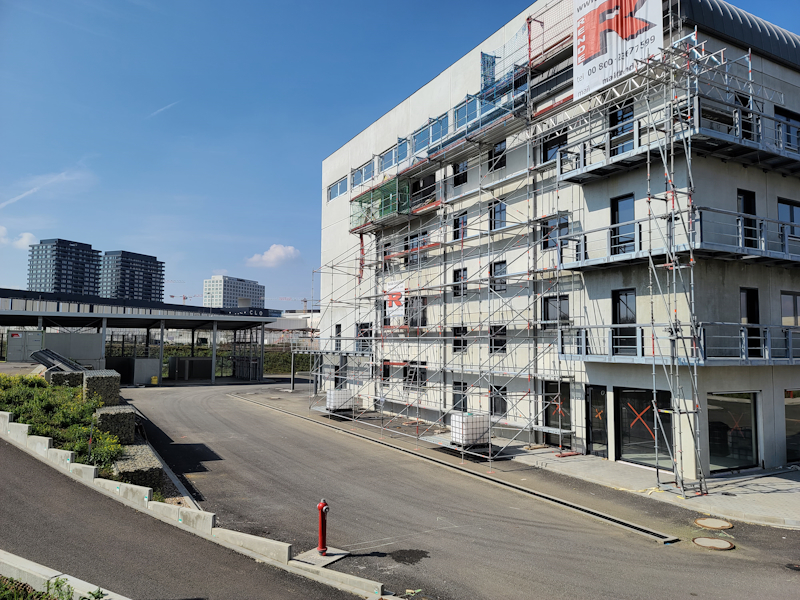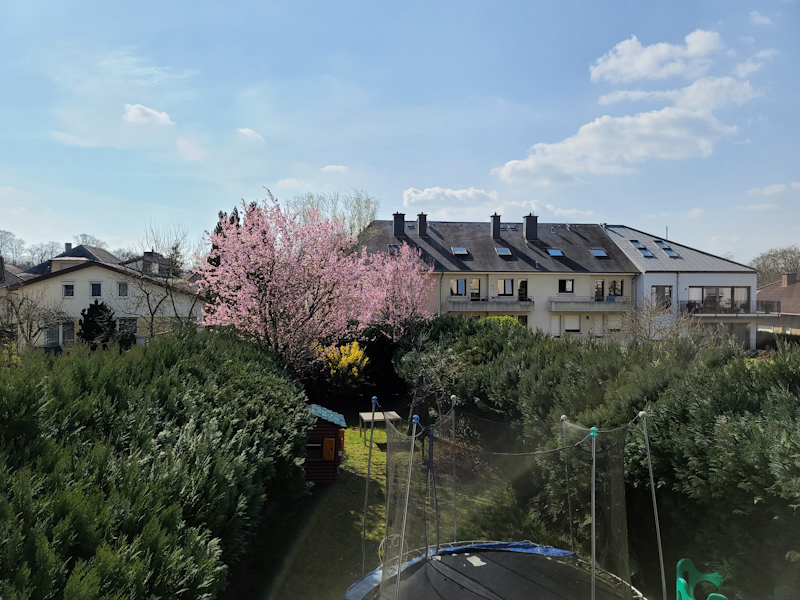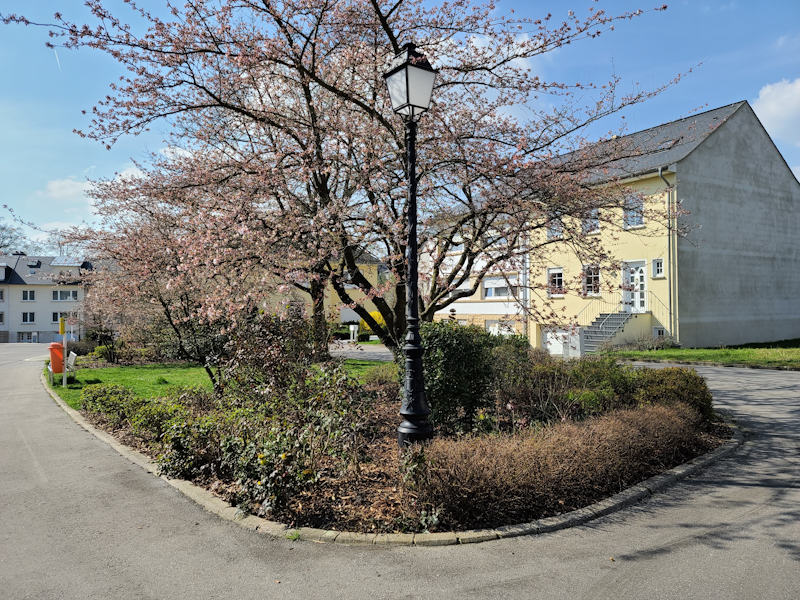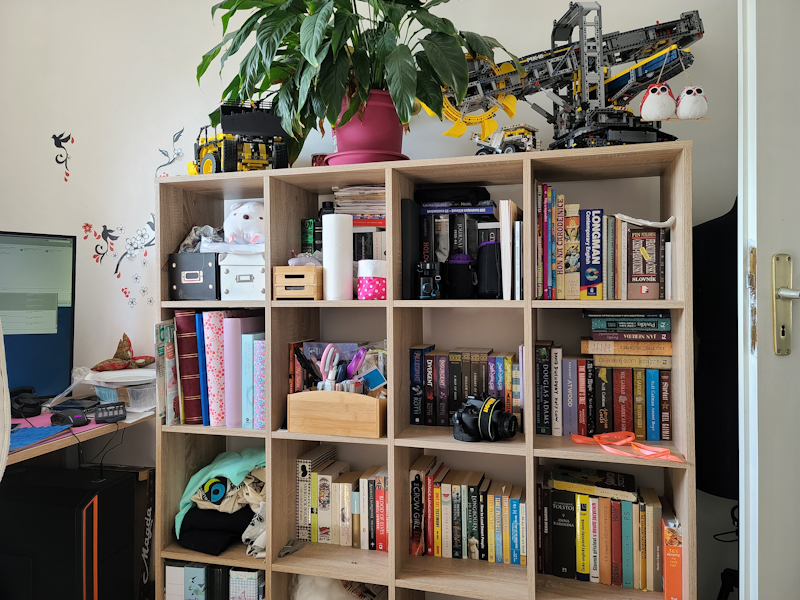The Samsung Galaxy S20+, S20 Ultra Exynos & Snapdragon Review: Megalomania Devices
by Andrei Frumusanu on April 3, 2020 9:30 AM ESTCamera: Daylight Evaluation Continued
I focused on the differences between the S20 devices until now, so let’s take a better look at how they compare against the competition and their predecessors.

[ Galaxy S20U - (S) ]
[ Galaxy S20U - (E) ]
[ Galaxy S20+ (E) ]
[ Galaxy S10+ (S) ] - [ Galaxy S10+ (E) ]
[ iPhone 11 Pro ] - [ Pixel 4 ]
[ Mate 30 Pro ] - [ P30 Pro ]
[ X-T30 ]
On the main camera units, things actually don’t differ all too much in terms of compositions between the different devices. I maybe would have wished for a bit brighter highlights as the phones are again still to shy on those last 10% of levels which didn’t quite convey the sun-lit façade of the building.
The high-light texture retention and sharpening comments made earlier again apply here to both the S20 Ultras. I prefer the Exynos shot as it’s more natural, but it’s a subjective preference choice.
The Ultra-Wide angle is really good in terms of exposure and dynamic range on the S20’s, however I do see the reduction in resolution compared to the S10 as the new phone actually does see a downgrade in the amount of captured details.
I don’t know what’s happening on the Exynos S20 Ultra unit’s Ultra-Wide, but there’s this blob of blurriness in the very center of the image on both phones. It’s as if the phone was trying to do some image fusion with another sensor but failing at it spectacularly. This isn’t present on the S20+.

[ Galaxy S20U - (S) ]
[ Galaxy S20U - (E) ]
[ Galaxy S20+ (E) ]
[ Galaxy S10+ (S) ] - [ Galaxy S10+ (E) ]
[ iPhone 11 Pro ] - [ Pixel 4 ]
[ Mate 30 Pro ] - [ P30 Pro ]
[ X-T30 ]
The S20’s main competition is the iPhone 11, and frankly here they’re losing out to Apple when it comes to the composition of the scene, as the 11 Pro is able to maintain much better dynamic range without clipping the blacks as badly as on the Galaxy phones. In terms of details I also prefer the iPhone as it’s producing a much more natural look. The Snapdragon S20 Ultra’s over-sharpening is again far too much and doesn’t look good, particularly on artificial objects and contours.
The Ultra-Wide here is also a straight down-grade from what we saw on the S10, with lower resolution and worse dynamic range.
Briefly looking at the super-high res images again, it’s as if the two S20 Ultras had completely different sensors as the Snapdragon unit is again far blurrier and feels lower resolution as to what the Exynos is able to achieve. However here it’s the S20+’s 64MP unit which shines as it’s able retain a lot more detail than either Ultra – check out the book shelves on the center-left side.

[ Galaxy S20U - (S) Auto ]
[ Galaxy S20U - (S) Tap ]
[ Galaxy S20U - (E) Auto ]
[ Galaxy S20U - (E) Tap ]
[ Galaxy S20+ (E) Auto ]
[ Galaxy S20+ (E) Tap ]
[ Galaxy S10+ (S) ] - [ Galaxy S10+ (E) ]
[ iPhone 11 Pro ] - [ Pixel 4 ]
[ Mate 30 Pro ] - [ P30 Pro ]
[ X-T30 ]
The S20 phones here had some problems for actually exposing for the foreground of the scene instead of the sky or the actual sun. The S10+E and Pixel 4 are actually amongst the best devices here, but still quite a bit far from the raw dynamic range of the scene (See X-T30 reference). There’s also some severe lens flaring here that wasn’t as prevalent is past devices – again likely due to the larger sensor sizes this year.

[ Galaxy S20U - (S) ] - [ Galaxy S20U - (E) ]
[ Galaxy S20+ (E) ]
[ Galaxy S10+ (S) ] - [ Galaxy S10+ (E) ]
[ iPhone 11 Pro ] - [ Pixel 4 ]
[ Mate 30 Pro ] - [ P30 Pro ] - [ X-T30 ]
Here’s also a scene where I think the new S20’s fail to compete with the iPhone 11 Pro in terms of either detail or dynamic range processing. It’s an upgrade over the S10 series, but I had expected more out of the camera hardware.
These samples also showcase some odd behavior between the Snapdragon and Exynos at 108MP resolution. The latter is just again massively sharper, showing more natural resolution. On the Snapdragon when you closer on the tree branches you see a ton of ghost images. I think what’s happening here is that the phones are taking multiple shots for the HDR compositing, but the Exynos is able to do this in a more optimized way. Also check out the left background buildings on the Snapdragon – it’s a ton sharper and seemingly more in focus, probably a sign that the two phones are focusing on totally different things.

[ Galaxy S20U - (S) ] - [ Galaxy S20U - (E) ]
[ Galaxy S20+ (E) ]
[ Galaxy S10+ (S) ] - [ Galaxy S10+ (E) ]
[ iPhone 11 Pro ] - [ Pixel 4 ]
[ Mate 30 Pro ] - [ P30 Pro ] - [ X-T30 ]
In an indoor shot, the S20 phones also fail to catch up with the iPhone 11. The new phones are certainly upgrades to the S10 series, but I think the dynamic range is a bit lacking and then there’s again the issue of sharpness – over-sharpening on the Snapdragon phone, and the general optics concerns all the models.
Overall Daylight Conclusion – Somewhat Disappointing
The S20 series feel like they’re overpromising and under-delivering on their camera capabilities when it comes to captures. Samsung delivered some incredible hardware here when it comes to the paper specifications, but I feel that it fell short of actually materializing in actual better camera captures.
Starting off with the S20 Ultra: The phone’s telephoto module does deliver on its promises, and the combination of a 4x optical magnification module with a 48MP sensor achieves some incredible zooming capabilities that are clearly far ahead of any other device on the market today. There’s not much more to say here – if you want a phone with an excellent telephoto module, then the S20 Ultra is the obvious choice.
The S20 Ultra’s 108MP main camera was quite unconvincing to me in the daylight shots. There are several layers that we have to peel apart here. First of all, there are very obvious processing differences between the Snapdragon and Exynos models this year. While on the S10 series this was in favor of the Snapdragon, I feel the other way around for the S20 series as the sharpening on the S20 Ultra here has gone absolutely haywire on all the camera’s modules, going beyond what one would consider an improvement of picture quality into the realm of actually being detrimental to the picture. The Exynos variant here seemingly has no sharpening processing at all, and it feels a ton more natural.
On the matter of the 108MP picture shots, there’s also very stark differences between the two variants of the phone, and the Exynos model somehow is consistently ahead in terms of the sharpness and natural resolutions of the shots. I don’t know what the cause for this is, but the two phones clearly are using very different mechanisms to get to the end results.
Lastly and most importantly, I feel like the optics of the modules aren’t able to keep up with the camera sensors. I feared this would happen because of the sensor’s humongous size, and it did show up in the images, and the edges of the picture just aren’t as sharp as on phones with smaller sensors, including the S20+.
The S20 Ultra’s massive quality hole in the 1.1x to 3.9x zoom range is just atrocious. Samsung here severely lags behind Huawei’s processing prowess in actually using the 108MP’s full resolution during the sensor fusion, and particularly shots in the 2x range just look really bad compared to the S20+ and other phones with 2x optical modules. The current software solution of stitching the telephoto module picture into the middle of a digitally magnified 12MP shot just feels like some intern’s implementation. Samsung has the hardware ability to address this, but let’s see on whether they’ll do this.
The Ultra-Wide module also feels like a downgrade compared to the S10 series. I’ve most used this module in daylight settings anyway and I loved the results on the S10 series, and the loss of resolution on the S20’s here is just a negative with essentially no added positives for the new module.
Finally, the S20+’s camera system, at least in daylight, seems like a much more sensible configuration. It doesn’t suffer as badly from the optics on the main sensor, and Samsung’s implementation of the 64MP sensor as a secondary wide-angle resolves the problems of having mediocre intermediary zoom levels. Sure, it doesn’t zoom quite as far and clear as the S20 Ultra, but it’s in line with current 2x optical modules and even slightly outperforms them beyond that, resulting in useable 3-4x shots with plenty of clarity. Ironically enough, I also find that the 64MP shots on the S20+ more often than not actually beats the 108MP shots of the S20 Ultra due to the better optics – although these are not perfect as there’s evident hazing in very high contrast objects.
Frankly, I’m quite disappointed in the results of the S20 series. They’re still good, and represent upgrades to the S10 series in most scenarios, but they fall short of the overhyped expectations. I think Apple’s iPhone 11 Pro’s main sensor quality and pictures are still a step above what the S20’s can deliver in daylight, with cleaner, sharper and more natural results. Huawei also is seemingly years ahead of Samsung when it comes to complex camera systems like the one employed on the S20 Ultra, having much better optics and the proper software processing to actually deal with the multiple modules.










137 Comments
View All Comments
MAGAover9000 - Tuesday, April 7, 2020 - link
I have the s10+. Fantastic device. Very happyid4andrei - Friday, April 3, 2020 - link
No need for me to praise this review any longer. Still, I must nitpick. The 3dmark GPU test always has caveats in your reviews. Drop it if you feel it is detected by OEMs or it's a false GPU test like the physics one.On web tests. I read on wiki that JetStream is an Apple made test, literally. Wouldn't you say that's a big caveat when testing against ios? Similarly Speedometer is developed by the webkit team at Apple. With Android webview based on Blink, not webkit, wouldn't Android smartphones be at a disadvantage against iphones? I don't see Kraken(Firefox) or Octane(Google) being used.
Kraken would actually be neutral to both. Other 3rd party tests might be Testdrive(Microsoft) or Basemark.
Andrei Frumusanu - Friday, April 3, 2020 - link
I don't think that the fact that the WebKit team made those tests is a valid argument against using them. You can go and read the source JS yourself if you wish, and they're industry accepted benchmarks. Both Kraken and Octane are ancient and outdated and we dropped them just like we dropped SunSpider of the early days.id4andrei - Friday, April 3, 2020 - link
Thank you for the prompt answer.s.yu - Friday, April 3, 2020 - link
Thank you Andrei, again the most comprehensive and reliable set of samples anywhere!There seems to be considerable sample variation again (last time with Samsung was the main module since S9 with the variable aperture) in the UWA, S20+E and S20UE should have absolutely identical UWA performance but the S20UE seems to have far worse sagittal resolution than the S20+E, and Samsung's processing isn't that good in the first place, considering the 12MP 1.4μm could produce incredibly sharp pictures as that been the specs of the Pixels' main module for generations.
I don't regret their switch to f/1.8 because the old module that went up to f/1.5 wasn't sharp wide open, especially in the corners, but a further two stops' variation to f/3.3 could be useful for more DoF in closeups provided inserting that physical aperture into the tiny module doesn't compromise the optical design otherwise.
This time around the E seems to generally outperform the S, except in color as E doesn't seem to have proper color fidelity...almost as if chroma NR is set too high even in broad daylight, and the "hybridization" of the digital zoom, in which the E clearly uses a smaller portion from the periscope's readout than the S in the resulting merge. Speaking of the zoom, S20+ still performs slightly worse at 2x(16MP readout) than S10's native 12MP, though the difference is small and could be down to lens variation. Considering S10U's Z height, they could've easily fixed the S20U like Xiaomi, going 1/2.3" f/2 12MP with the 2x. Xiaomi used it despite a 4-1 bin, all the more reason to use it with a 9-1 bin. S20U's corner performance at 3x would also be much improved.
Regarding the comparison with the Fuji though, I suspect your unit has trouble focusing to infinity correctly, because the train and forest samples show clear superiority of the Fuji's zoom. I especially recognize that kind of slight haziness as being very responsive to dehaze and low radius sharpening in LR and would result in far more detail with extraction in post. Also, with an ILC, there's always stopping down a little for more sharpness and more DoF.
Regarding the full res modes, it's not worth storing 108MP of data with the CFA asking for a 9-1 bin, of course the 64MP would be better, without the RAW it's hard to say for sure, but the 64MP seems to be quad bayer.
s.yu - Friday, April 3, 2020 - link
I don't agree with your remark about the night comparison with Mate30P though, the UWA is not "UW" so it has better image quality, that's true, and the night mode of the Mate30P is far superior, that's also true, but not auto mode, nor any aspect of the telephoto as it's clearly using a crop of the main for 3x. Samsung does attempt to use the 4x for telephoto and although there's a significant issue of chroma noise, it's far sharper than Mate30P's crop, with at least twice 3 times the effective resolution in night mode. With S20U you could also crop out a single shot 3-4x of similar brightness to the Mate30P crop, but it's just a crop.As for the potential of P40P surpassing S20U, that model operates on a 9.4MP crop by default, interpolated to 12.5MP which clearly has consequences. In daylight it's often a regression compared to P30P (much less match Mate30P), and in night shots using the current firmware it has severe color issues of rendering large portions of the scene as a crimson red, so it's hard to say at this point too.
s.yu - Friday, April 3, 2020 - link
Oh, there's exception of the Mate30P auto mode in the last sample, but the night mode isn't constantly superior either.RealBeast - Friday, April 3, 2020 - link
I've been looking forward to getting one of these, not sure which yet. The fly in the ointment now is that I won't see my Mom (who gets my old S9+) until the Fall due to the whole COVID problem, not to mention less income. That will weigh heavily on sales of what is otherwise an amazing looking phone for me.29a - Friday, April 3, 2020 - link
How large are the picture file sizes created by this thing?BedfordTim - Sunday, April 5, 2020 - link
The same size as any other 12MP camera. They will depend on content, hdr, motion and compression options but I would expect about 36MB for a raw image and 8MB for a high quality jpeg.